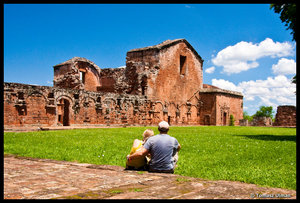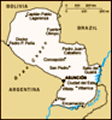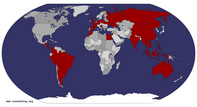Advertisement
Published: January 7th 2013

 taking in the history
taking in the history
just us and the ruinsCrossing a border to a new country is always a little bit stressful even if you have done it hundreds of times. In the end it is all new, starting with people and their attitude, money that you have to change and get used to, price levels and orientation. Little did we know about Paraguay except for the fact, that it is by far the most unacknowledged by travelers part of South America. Information you find is a little bit confusing as on one hand it is supposed to be the most secure country in SA and on the other hand Brazilians would swear it is deadly dangerous. One can think that this coming from them is a big statement.
The bridge linking Brazil and Paraguay is also supposed to be a dangerous place to walk along and we were unsure if we want to cross it by foot or if we should take a bus/taxi. When we got to the Brazilian immigration point we saw trucks full of soldiers, DEA and INTERPOL agents. ‘
What the hell is this place?’ – we thought. We asked the woman who was stamping us out if it was ok to walk alongside the
bridge and she just looked at all the military around and smiled. Sure it was, at least that day :-) Later on we read online that a few days later after our crossing all those agencies made a major bust of the leading drug cartel in a region confiscating 1500kg of cocaine and arresting 20 people. I guess that was what they were waiting for;-)
In the Paraguayan immigration booth you can find a very useful Tourist Information Centre which already was something unexpected for us. If this country has such a poor tourist infrastructure how come they distribute best leaflets and maps we have ever seen? Confusing, again. We took all the maps and pamphlets we needed for our trip, got money out of the ATM (in the shopping centre opposite immigration) and hoped on a bus to the terminal. The change in landscape was incredible. We were already used to all those modern looks and comforts of the countries we visited so taking a chicken bus was like a rude awakening. It took us a few hours to take it all in and we finally started to appreciate being of the tourist trail again. The landscape on
the way to Encarnacion was incredibly beautiful. Lush green gardens filled with mango and palm trees, horses and cowboys everywhere and old, colorful architecture. The 5 hours filled with music, great views and staring from the window went by so quickly that by the time we realized we had to get off.
Ruta Jesuitica We went to a LP recommended Hotel Germano (70,000G/15$), strategically located just by the bus terminal and dropped our bags off. Finally we could enjoy a private room without ruining our daily travel budget.
Encarnacion is not a very special place and majority of people use it as a base for visiting nearby Jesuit ruins. That was exactly our plan. We read somewhere that Ruta Jesuitica is the least visited Unesco site in the world. We wondered if it was because of the place it was located (of the gringo trail) or the general looks of it. We felt special straight away for making an effort to come here anyway.
In the morning we hoped on a bus going towards
Trinidad (any bus going this direction would do) and 1h later we were dropped in front of the gates. It was boiling hot
but air smelled of flowers and fresh grass. Love spring season and after so many months spent in ‘always summery’ Asia it was simply fantastic. When they say you have great chances to have Trinidad ruins to yourself – it is very true. It could be one of the advantages of this highly unappreciated site. We bought a combo ticket for all the major ruins (25,000/5$) and started our exploration. We cannot even express how much we loved this place. People say they are only ruins but when you put some imagination behind it you can see its former splendid and beauty. Surprisingly a lot of main buildings remained well preserved and you can see beautiful carvings, alcoves and statues. Jesuits build here an astonishing settlement back in the 18
th century and their accomplishment is easy to notice. Because it is located quite far from any major town or busy road it is also incredibly peaceful. There was nobody else around, just us. Extraordinary, although it is hard to understand why they were just kicked out of this place leaving it to crumble down…
Even though it is said that Trinidad is not very English friendly we were surprised
to see a nice expo with English signs and a few minutes long movie explaining the history of Ruta Jesuitica including Trinidad and other sites. I was really positively surprises and hungry to see more. We knew that getting to the next ruins of
Jesus would be more tricky but we managed to find a moto-taxi (rickshaw) whose driver agreed to take us there and back for 50,000G/10$. Not much if you think about it and it saved us a walk of 12km one way in a very hot weather. Suddenly we felt like in Asia, taking a rickshaw ride through the landscape filled with trees. Jesus proved to be another beautiful example of Jesuit architecture although not as fabulous and as deserted as Trinidad. We were surprised to see 2 other tourists visiting. It took us nearly whole day to see both sites but we were really happy with that time. Apparently the third one –
San Cosme is even more stunning.
Unfortunately buses to San Cosme go only in the afternoon so we would not have been able to come back the same day and nobody was able to advise us if we could stay there. Only
later on we found out that every Jesuit site has a hostel and a camp site attached to it (some government program) so there is always place to stay for visitors. If only we had known that…. Because we did not, we just took a bus to Asuncion for some nice colonial sights and CS time.
Mother of All Cities We got to
Asuncion and took a local bus towards New Downtown area to meet our CS host – Chalo. It is called new because there was a shift of development in the capital a few years back when city council put enormous taxes on properties in the historic area and all the young and wealthy moved out south. Trendy bars, restaurants and shopping centers followed accordingly creating new and safe neighborhood. The colonial mansions in the historic area were left crumbling and favelas started to build up around them. Chalo lives in a fabulous garden villa just next to wealthy and important people like head of UN office and many ambassadors. It is hard not to notice their fabulous mansions with police and guards in front of them.
Here in this place the thin line between
extravagantly rich and very poor is already visible. Just 100m away people leave under the bridge – so sad, but very real in Paraguay. Chalo was an amazing host and we spent many days talking about culture, history of Paraguay, food and drinks. He gave us a lot of tips of what to try and what to eat as well as he took us to a local grill bar and helanderia for dulce de leche delights. We had a great time sitting in a garden, drinking
terre (ice cold yerba matte) and sharing experiences. The relaxed way of Paraguayans is easily appreciated – they are walking slowly around with their beautiful terre thermoses and smiling all the time.
Chalo explained to us what role Paraguay plays in the South America’s drug business since apparently this small and generally unnoticed country, with a very corrupted government acts as a major distribution centre for drugs, moving majority of its quantities south of Bolivia (production centre). The north of SA and Central America is controlled by Colombia. Even though drug addiction is not a big social problem here, many people live/get wealthy of this trade. What stuck us then was a fact

 city bus
city bus
in Asuncionhow laid-back Chalo was about the whole thing as if it was so obvious to everybody.
The visit to the historic center was great too. On the way there, alongside the
Av. Marsical Lopez we noticed the most amazing colonial buildings ever. One of them could have been easily our dream house … so stylish and grand. We started our tour near
Estacion Ferrocarril (train station) where we visited the best railway museum ever. Little did we know then that it was actually here in Asuncion where the fist South American railway project began. Not so surprising when you find out that Asuncion used to be called
‘Mother of All Cities’ as it was of a great importance during the colonization time. When Spaniards were kicked out of Buenos by Guarani - native Americans, it was here that they founded their strategic city. The museum offers an amazing collection of railway artifacts – from ‘orient express’ style carriages, ticket machines to engines and photos. It was like a walk down the memory lane, seriously. We were surprised by the fact that all those objects were still there and not in private collections of antique enthusiasts or shops.
With
that escalating our spirits we walked around town admiring churches, villas and other buildings that have seen better times in their colonial past. We visited many other museums and finally finished in
Menzana de la Rivera – complex of 8 colonial houses converted into a Culture Centre and museum. We were especially interested in their section about Chaco region as that was the place we were planning on visiting next.
One day we even (against heat and humidity) decided to visit nearby town of Aregua well known for its ceramics and nice surroundings. Even though it is located 20km or so from Asuncion it is possible to get there by a city bus. Chalo told us that we should expect cheese instead of artsy but we thought that it was worth a trip anyway. Aregua proved to be a very cute, historic town overlooking a lake with cobbled, shady alleys and street stalls. Even though its streets are lines with exquisite colonial villas it has a very distinctive village atmosphere. We really enjoyed our stroll down the alleys full of kitschy pottery, had some fresh fruit and snacks and just relaxed in a shade. We began to learn the
slow paced lifestyle here and we can honestly say it is very easy to get used to…..
Additional Info: •
The bus ticket you buy on the Brazilian side (4BR/2$) is for Ciudad del Este terminal and covers all the hop in – hop out stops (i.e. immigration on both sides) so you pay only once) •
Interesting fact #1: you cannot find mango or guava in a supermarket as they simply grow on every corner. Chalo told us that mango is considered a ‘PIG’s food’ so people don’t eat it. I shall remember that when paying my 2£ for one fruit in London;-) •
Interesting fact #2: Tourism in Paraguay has developed very little outside of Asunción, despite the potential of attractions such as Ciudad del Este's retail area and ruins of Jesuit missions. The nation has only 11,000 beds (more than half in Asunción), 34 percent of which are in luxury or five-star hotels, and 52 percent of which are in three-or four-star hotels. Small establishments account for the remainder. Just over 400,000 tourists visit Paraguay each year, 70 percent of which come from Brazil, Argentina, andUruguay… how about the rest of us? (source: http://www.nationsencyclopedia.com/economies/Americas/Paraguay.html)
Advertisement
Tot: 0.1s; Tpl: 0.03s; cc: 10; qc: 25; dbt: 0.0322s; 1; m:domysql w:travelblog (10.17.0.13); sld: 1;
; mem: 1.1mb


























D MJ Binkley
Dave and Merry Jo Binkley
Can't believe everything you hear
As you've proven it is best to check it out yourself. Everyone has different impressions. We'll join you in eating those mangos.